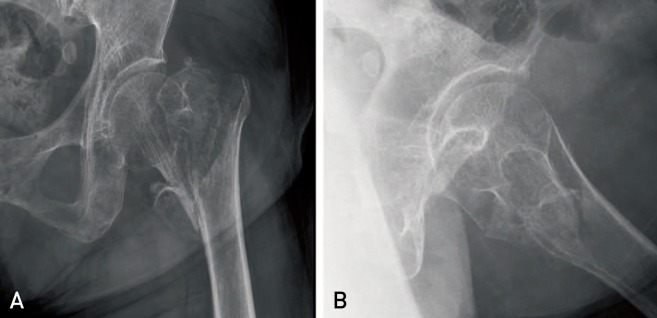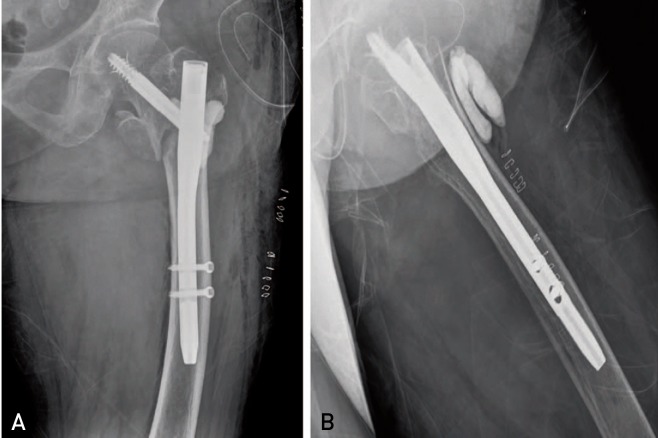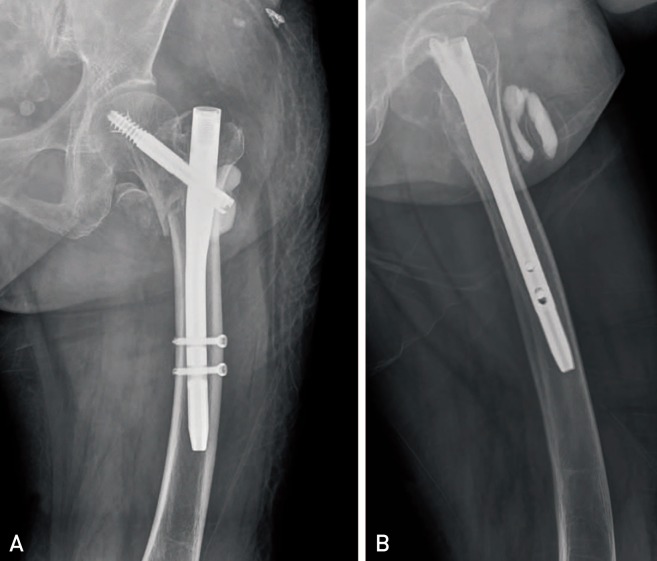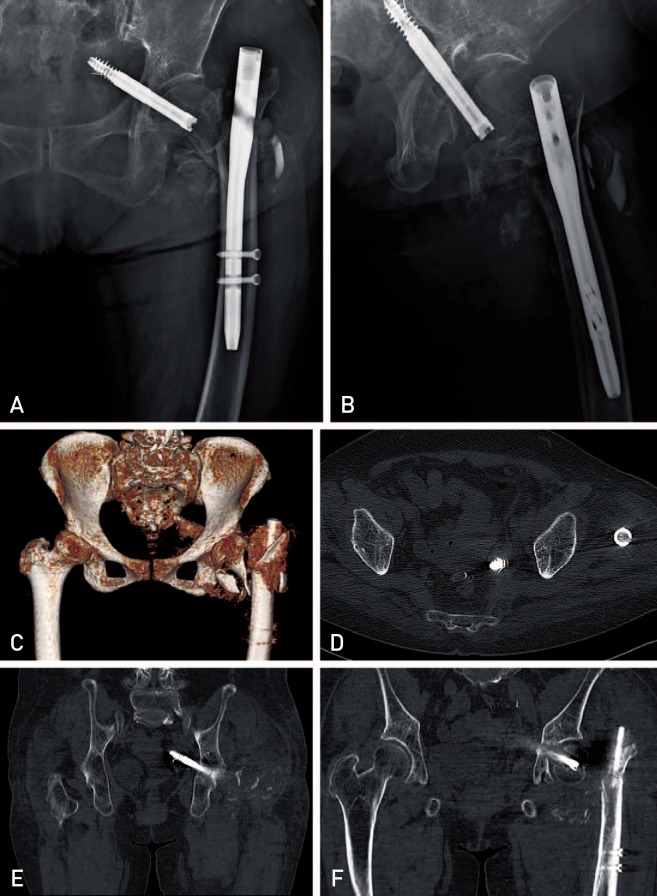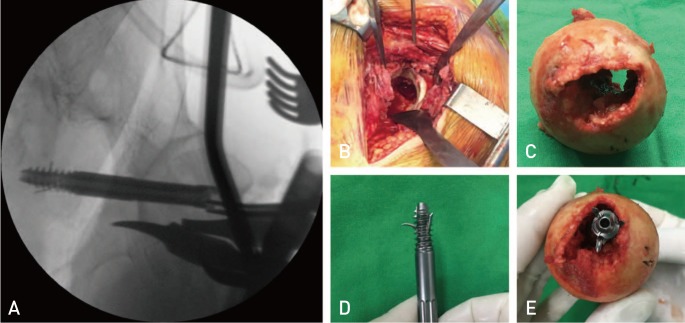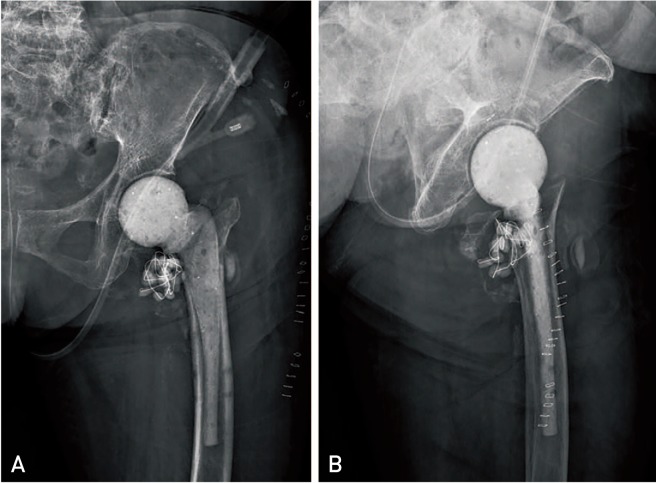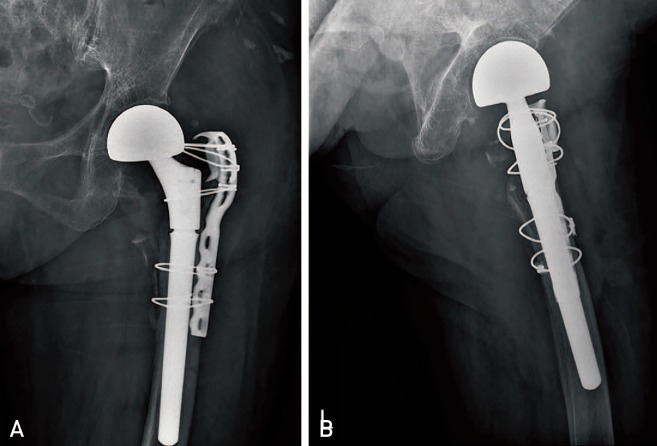Hip Pelvis.
2019 Jun;31(2):110-119. 10.5371/hp.2019.31.2.110.
Intrapelvic Migration of the Lag Screw with Wedge Wing from Dyna Locking Trochanteric Nail: A Case Report and Literature Review
- Affiliations
-
- 1Department of Orthopedic Surgery, The Catholic University of Korea, Yeouido St. Mary's Hospital, Seoul, Korea. ssewon@naver.com, ssewon@gmail.com
- 2Department of Orthopedic Surgery, The Catholic University of Korea, Daejeon St. Mary's Hospital, Daejeon, Korea.
- 3Department of Orthopedic Surgery, College of Medicine, The Catholic University of Korea, Seoul, Korea.
- KMID: 2448030
- DOI: http://doi.org/10.5371/hp.2019.31.2.110
Abstract
- The intrapelvic migration of cervicocephalic lag screws is a rare complication after intertrochanteric fracture synthesis with an intramedullary nail. Only 15 cases of intrapelvic penetration by three different instrument systems have been described in the literature. However, to our knowledge, there is no report of intrapelvic migration of the lag screw with wedge wing designed to increase fixation power using the Dyna locking trochanteric (DLT) nail. We present a case of intrapelvic migration of the lag screw with wedge wing from DLT nail. The patient described herein underwent a two-staged operation of implant removal without intrapelvic approach followed by bipolar hemiarthroplasty. With intrapelvic migration conditions, although it is not uncommon to require an additional intrapelvic approach, this modification can lead to lethal consequences. For this reason, it is recommended to coordinate with the vascular surgery department due to the close proximity of the major vessels.
Keyword
MeSH Terms
Figure
Reference
-
1. Kenzora JE, McCarthy RE, Lowell JD, Sledge CB. Hip fracture mortality. Relation to age, treatment, preoperative illness, time of surgery, and complications. Clin Orthop Relat Res. 1984; (186):45–56. PMID: 6723159.2. Hardy DC, Descamps PY, Krallis P, et al. Use of an intramedullary hip-screw compared with a compression hip-screw with a plate for intertrochanteric femoral fractures. A prospective, randomized study of one hundred patients. J Bone Joint Surg Am. 1998; 80:618–630. PMID: 9611022.
Article3. Chevalley F, Gamba D. Gamma nailing of pertrochanteric and subtrochanteric fractures: clinical results of a series of 63 consecutive cases. J Orthop Trauma. 1997; 11:412–415. PMID: 9314147.
Article4. Hesse B, Gächter A. Complications following the treatment of trochanteric fractures with the gamma nail. Arch Orthop Trauma Surg. 2004; 124:692–698. PMID: 15517321.
Article5. Weil YA, Gardner MJ, Mikhail G, Pierson G, Helfet DL, Lorich DG. Medial migration of intramedullary hip fixation devices: a biomechanical analysis. Arch Orthop Trauma Surg. 2008; 128:227–234. PMID: 17985147.
Article6. Thein E, De Cannière A, Burn A, Borens O. Medial migration of lag screw after gamma nailing. Injury. 2014; 45:1275–1279. PMID: 24933440.
Article7. Tauber M, Resch H. Sigmoid perforation after medial migration of lag screw in gamma nailing. Arch Orthop Trauma Surg. 2006; 126:118–122. PMID: 16402202.
Article8. Takasago T, Goto T, Toki S, et al. Intrapelvic migration of the lag screw in intramedullary nailing. Case Rep Orthop. 2014; 2014:519045. PMID: 25610680.
Article9. Robinson SJ, Fountain JR, Torella F, Pennie BH. Intrapelvic migration of a lag screw from a cephalomedullary femoral nail: a case report. Injury. 2011; 42:1384–1386. PMID: 21334619.
Article10. Ramkumar U, Saffar N, Thinakarajan T, Parmar HV. Pelvic migration of lag screw from a nailing device. Inj Extra. 2006; 37:53–55.
Article11. Pinheiro AC, Alpoim B, Félix A, Alves C, Sousa C, Rodrigues A. Medial migration of the intramedullary Gamma 3 nail - a case report. Rev Bras Ortop. 2016; 51:720–724. PMID: 28050546.
Article12. Lucke M, Burghardt RD, Siebenlist S, Ganslmeier A, Stöckle U. Medial migration of lag screw with intrapelvic dislocation in gamma nailing--a unique problem? A report of 2 cases. J Orthop Trauma. 2010; 24:e6–e11. PMID: 20101128.
Article13. Lozano-Alvarez C, Alier A, Pelfort X, Martínez-Díaz S, Puig L. Cervicocephalic medial screw migration after intertrochanteric fracture fixation, OTA/AO 31-A2, using intramedullary nail Gamma3: report of 2 cases and literature review. J Orthop Trauma. 2013; 27:e264–e267. PMID: 23515128.14. Li X, Heffernan MJ, Kane C, Leclair W. Medial pelvic migration of the lag screw in a short gamma nail after hip fracture fixation: a case report and review of the literature. J Orthop Surg Res. 2010; 5:62. PMID: 20799945.
Article15. Lee JW, Cho HM, Seo JW. Intrapelvic penetration of lag screw in proximal femoral nailing: a case report. J Korean Fract Soc. 2017; 30:203–208.
Article16. Lal H, Sharma DK, Mittal D. Intrapelvic migration of hip lag screw of proximal femoral nail-sequele to a paradoxical reverse Z effect and their critical analysis. J Clin Orthop Trauma. 2012; 3:48–53. PMID: 25983456.
Article17. Heineman DJ, van Buijtenen JM, Heuff G, Derksen EJ, Pöll RG. Intra-abdominal migration of a lag screw in gamma nailing: report of a case. J Orthop Trauma. 2010; 24:e119–e122. PMID: 21063215.
Article18. Flint JH, Sanchez-Navarro CF, Buckwalter JA, Marsh JL. Intrapelvic migration of a gamma nail lag screw: review of the possible mechanisms. Orthopedics. Published online April 16, 2010. DOI: 10.3928/01477447-20100225-19.
Article19. Temiz A, Durak A, Atici T. Unstable intertrochanteric femur fractures in geriatric patients treated with the DLT trochanteric nail. Injury. 2015; 46(Suppl 2):S41–S46. PMID: 26021665.
Article20. Kim YS, Yoon JW, Han SK. Treatment of intertrochanteric fracture of the femur using a dyna locking trochanteric (DLT) nail. J Korean Hip Soc. 2010; 22:216–221.
Article21. Kim SS, Lee KY, Kim CH, et al. Comparison of the dyna locking trochanteric nail, proximal femoral nail antirotation and gamma 3 nail in treatment of intertrochanteric fracture of the femur. Hip Pelvis. 2013; 25:211–219.
Article22. Gunay C, Atalar H, Altay M, Yavuz OY, Yildirim AO, Oken OF. Does the wedge wing in the neck screw prevent cut-out failure in Ota/AO 31-A2 trochanteric fractures in elderly patients? Acta Orthop Belg. 2014; 80:26–33. PMID: 24873081.23. Brunner A, Büttler M, Lehmann U, et al. What is the optimal salvage procedure for cut-out after surgical fixation of trochanteric fractures with the PFNA or TFN?: a multicentre study. Injury. 2016; 47:432–438. PMID: 26748415.24. Werner-Tutschku W, Lajtai G, Schmiedhuber G, Lang T, Pirkl C, Orthner E. [Intra- and perioperative complications in the stabilization of per- and subtrochanteric femoral fractures by means of PFN]. Unfallchirurg. 2002; 105:881–885. German. PMID: 12376894.25. Rebuzzi E, Pannone A, Schiavetti S, et al. IMHS clinical experience in the treatment of peritrochanteric fractures. The results of a multicentric Italian study of 981 cases. Injury. 2002; 33:407–412. PMID: 12095720.
- Full Text Links
- Actions
-
Cited
- CITED
-
- Close
- Share
- Similar articles
-
- Outcomes of Wedge Wing in the Lag Screw for Unstable Intertrochanteric Fractures in Elderly Patients
- Intrapelvic Penetration of Lag Screw in Proximal Femoral Nailing: A Case Report
- Treatment of Intertrochanteric Fracture of the Femur Using a Dyna Locking Trochanteric (DLT) Nail
- Comparison of the Dyna Locking Trochanteric Nail, Proximal Femoral Nail Antirotation and Gamma 3 Nail in Treatment of Intertrochanteric Fracture of the Femur
- Failure of a Rotation Control Gamma 3 Lag Screw Used to Treat a Trochanteric Fracture

